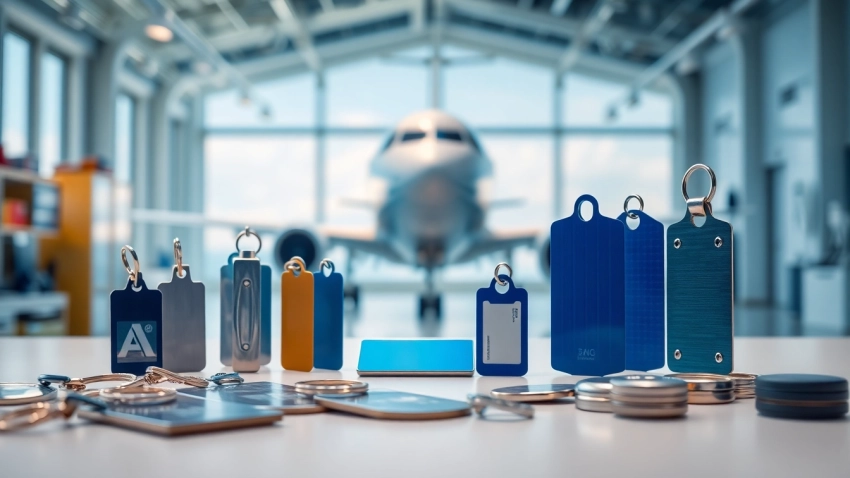
Understanding Aeronautical Tags: Their Importance and Applications in Aviation
The Role of Aeronautical Tags in Aviation
Aeronautical tags are essential tools in the aviation industry, facilitating organization, safety, and compliance throughout various stages of an aircraft’s life cycle. These tags serve as identification markers, providing crucial information that ensures equipment and parts remain serviceable and compliant with regulatory standards. Understanding their definition and types, as well as their importance for safety and compliance, is fundamental for anyone involved in aviation. For a comprehensive overview of their functionality, consider visiting Aeronautical Tags.
What Are Aeronautical Tags?
Aeronautical tags are labels or markers used on aircraft components to indicate various pieces of information such as serviceability, maintenance history, or inventory management. These tags ensure that each component is accounted for, and they help maintenance crews track the lifecycle of parts in aviation. Common forms of aeronautical tags include inspection tags, service tags, and identification tags, each serving a unique purpose.
Types of Aeronautical Tags and Their Uses
Several types of aeronautical tags are used within the aviation industry, each designed for specific functions:
- Inspection Tags: These indicate when a component has been inspected and its current status, such as “Approved for Return to Service” or “Unserviceable.”
- Identification Tags: Often made from durable materials, these tags are used to identify equipment and parts uniquely, often including barcodes or QR codes for digital inventory management.
- Maintenance Tags: These provide details about maintenance done on a particular component, including dates and personnel involved. This ensures a clear maintenance history for future audits.
- Warning Tags: Used to alert maintenance personnel of safety concerns, these tags can include information regarding which components must not be utilized or require immediate attention.
Importance of Aeronautical Tags for Safety and Compliance
Ensuring safety in aviation relies heavily on compliance with regulatory standards set by governing bodies. Aeronautical tags play a vital role in maintaining compliance by providing a clear record of inspections, serviceability, and maintenance history. Tags must adhere to federal regulations, thereby enhancing the overall safety of flight operations and minimizing risks associated with mechanical failures.
Materials and Manufacturing Processes for Aeronautical Tags
Common Materials Used
Aeronautical tags must be constructed from durable materials to withstand rigorous conditions encountered in aviation. Common materials include:
- Aluminum: Lightweight and resistant to corrosion, aluminum tags are often used in outdoor and high-humidity environments.
- Plastic: Durable plastics are utilized in applications requiring flexibility and resilience against temperature changes.
- Stainless Steel: Known for its strength and corrosion resistance, stainless steel is useful for tags that require extreme durability.
Manufacturing Techniques for Durability
Manufacturing processes for aeronautical tags involve several techniques to ensure durability and longevity:
- Engraving: Engraved tags offer deep and lasting markings, making them visible and accessible throughout their lifetime.
- Printing: Advanced printing techniques, such as UV printing, provide high-resolution images and text that withstand various environmental stresses.
- Die-Cutting: Custom shapes and sizes can be made through die-cutting processes to fit specific components or spaces on the aircraft.
Customization Options for Aeronautical Tags
Customization of aeronautical tags allows organizations to tailor the information presented on each tag. This can include:
- Company logos, enhancing brand visibility.
- Specific color coding to indicate different statuses or types of equipment.
- Barcodes or QR codes for digital tracking and inventory management.
Best Practices for Using Aeronautical Tags
Proper Tag Placement and Visibility
For aeronautical tags to serve their intended purpose effectively, proper placement is critical. Tags should be:
- Easily visible to maintenance personnel and pilots.
- Strategically placed on parts or components that require regular checks.
- Removable yet securely attached to avoid loss during operation.
Maintaining Tag Integrity Over Time
Tags must maintain their integrity to ensure consistent safety and compliance. This involves:
- Regular inspections to identify wear and damage.
- Replacing tags that exhibit fading or deterioration of material.
- Utilizing protective coatings to extend the lifespan of outdoor tags.
Regulatory Compliance with Aeronautical Tags
All aeronautical tags must meet the requirements set forth by aviation regulatory authorities. Organizations should regularly review compliance standards to ensure that:
- All tags contain accurate and up-to-date information regarding parts and maintenance.
- Tags are produced following the necessary specifications related to size, material, and legibility.
Innovations in Aeronautical Tags
Smart Aeronautical Tags and Digital Solutions
Smart aeronautical tags are revolutionizing the way information is tracked and managed in aviation. Utilizing RFID (Radio-Frequency Identification) technology, these tags allow:
- Real-time tracking of aircraft components and their serviceability.
- Seamless integration with maintenance software for efficient data management.
- Reduction in human error through automated data collection processes.
Eco-Friendly Tag Solutions in Aviation
As the aviation industry seeks to improve sustainability, eco-friendly tag solutions are emerging. Options include:
- Tags made from biodegradable materials that reduce environmental impact.
- Recycled materials for creating new tags, minimizing resource waste.
Future Trends for Aeronautical Tags
Looking toward the future, several trends are likely to influence the evolution of aeronautical tags:
- Increased use of augmented reality (AR) for training and maintenance, allowing technicians to visualize tag information in real time.
- Utilization of blockchain technology for improved traceability and security of parts and maintenance history.
Case Studies: Aeronautical Tags in Action
Real-Life Examples of Effective Tagging
Several aviation organizations have successfully implemented robust tagging systems. For instance, a mid-sized airline significantly reduced downtime by integrating an RFID tagging system that allowed for real-time tracking of maintenance schedules. This streamlined process improved the fleet’s availability and ensured compliance with maintenance regulations.
Lessons Learned from Tagging Failures
There are valuable lessons to be learned from instances where tagging systems failed. One notable incident involved an airline that faced operational disruptions due to the incorrect marking of maintenance tags. This case underscores the importance of training personnel on proper tagging protocols and regularly auditing tag usage to prevent future errors.
Evaluating the ROI of Aeronautical Tags
Investing in aeronautical tags can yield significant returns in terms of safety, compliance, and efficiency. Organizations can evaluate ROI by measuring reductions in maintenance costs, improvements in aircraft availability, and enhanced safety compliance records. A comprehensive analysis can help demonstrate the long-term benefits of a robust tagging system.












Leave a Reply